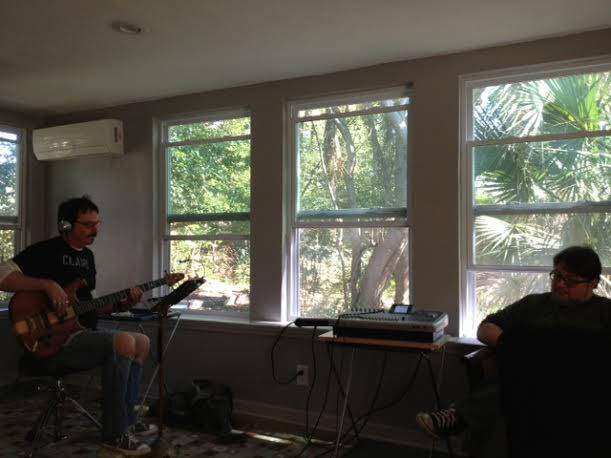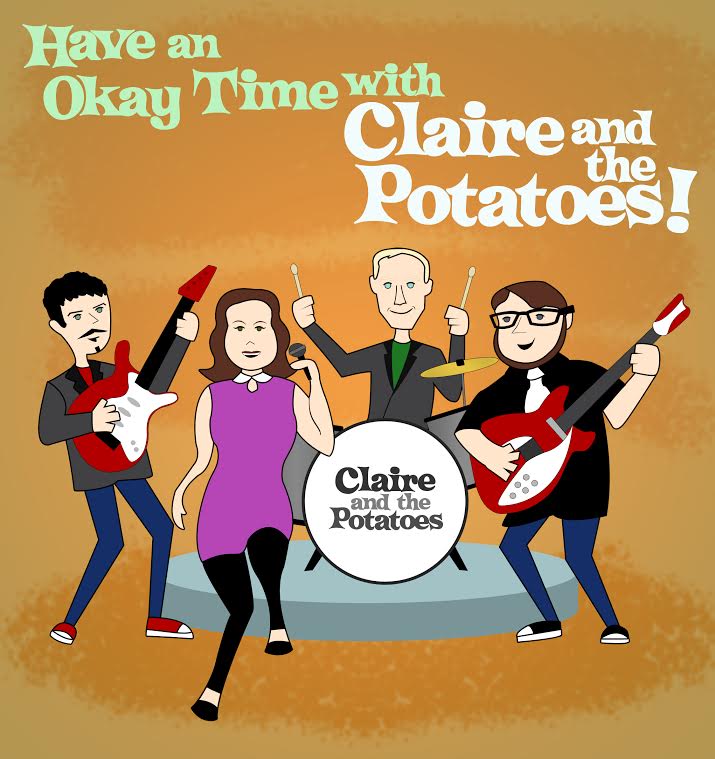 Claire and the Potatoes are an Orlando-based retro pop band who blend contemporary lyrics with a distinctive 60s throwback sound. Their debut album “Have An Okay Time With Claire And The Potatoes” comes out on Tuesday and we spoke with bandmember Marc Sirdoreus to get the inside story of the band and this exciting new album.
Claire and the Potatoes are an Orlando-based retro pop band who blend contemporary lyrics with a distinctive 60s throwback sound. Their debut album “Have An Okay Time With Claire And The Potatoes” comes out on Tuesday and we spoke with bandmember Marc Sirdoreus to get the inside story of the band and this exciting new album.
In part one of this interview Marc shared some of the song-writing process behind the album, and then in part two we discussed the transition from solo artist to playing in a band, and how to achieve that “band dynamic” with a group of musicians.
In this part we dive into the recording, mixing and mastering process that went into the album and the specific techniques which achieved the album’s remarkable sound. Essential reading for anybody recording their own music and working on ear training for audio frequencies, effects or mixing.
I thought that was one of the most interesting parts of the sound of the album: that Leslie’s voice is obviously very pure and it just comes across very intimately on several tracks. But at the same time, the overall sound of the album is quite heavy at times.
Can you tell me a bit about the musical aesthetic you were going for? What kind of sound you were imagining before you started recording this tracks?
Marc: Sure. Before we were playing together as a four piece, when it was going to be me recording everything, I kind of wanted things to be a little bit more throwback than they are—maybe even pre-Beatles—and I think that’s even best evidenced by our cover of Will You Love Me Tomorrow on our first EP. That was really where I imagined the group going. Guy and Jim and myself, we all share some very similar influences: we like Beatles records, we’re really into The Kinks, we’re really into The Who, and actually heavily into Black Sabbath.
You wouldn’t know it by listening to this record, but more often than not if we’re having an after rehearsal jam, we’re going to start playing Sabbath. And Leslie just naturally does have a very pure voice but she has a very versatile voice and that’s merely how she chose to sing these songs. Actually her delivery got a little more forceful as she got more confident in her role as a front person. If you were to listen to some of the demos, I would demo a song first and then I would have Leslie come in and replace my rather monotone vocals with her singing it. And they were actually a little bit more innocent on some of those demos, a little bit more “shy girl in the wilderness, deer in the headlights”-sounding and as she got more confident she got a little bit more forceful.
On Empirical Argument, Shot At Love and Lead Me On we hadn’t found the right place for Leslie’s voice to sit and there comes a time where you have to decide on the EQ and where it’s going to fit in the track. And it was really as a complete lark, I threw this distortion box on her already-recorded vocal part on Empirical Argument and just went “Or we could do this“ and I sort of chuckled… and she looked and went “Yeah, we can totally do that.”
She loved it and we went ahead and applied that to some other songs where it fit because it turns out that this joke ended up being a sound that we really liked. I don’t think there was any intentional aesthetic behind it. Maybe on Shot At Love where it’s possibly an evil song, but I think it was just a matter of it was a joke that ended up working.
Listen to the lightly-distorted vocals on Shot At Love
I did all of the recording and the mixing of the album.
It was strung out over months, but mostly because I kept getting sick in the early part of this year. I just kept getting these awful colds and if your head’s plugged up you can’t hear things properly and then how you can possibly mic things? And also I was being a gentleman and didn’t want to get everyone else sick!
The first session was at Jim’s house. We recorded in this addition to his house that’s very echoey and we merely recorded his drum parts all in one go, while Leslie and I were there playing along and we were recording that as well for guide tracks.
Mic placement and amp EQ settings became key. They were the king of the tone of this record.
Then a few weeks later (after I got over that horrific cold again) we did two sessions with Guy for the bass parts. Those were recorded in the same room, but instead of going direct he used a very small Vox amp—and I’m a big fan of anything Vox makes—so I simply close-mic’ed that with a nice little Shure microphone and didn’t really do much to his bass. There was a lot of limiting and compression of course, because if you’re looking for a tight rhythm section but you’re recording in an echoey space you do need to compact that sound a little bit.
Afterwards I took it home, mixed the rhythm tracks and I went on the task of recording the guitar parts, which were all done in the exact same very small not-really-equipped-for-recording box that I call an office. You can see examples of that in the videos that I made while making the Popular Music album. It’s a very, very small box. Mic placement and amp EQ settings became key. They were the king of the tone of this record.
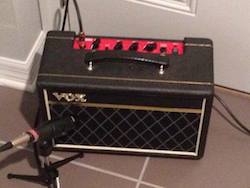
As Marc puts it: Little amp, big sound.
I never ended up playing through anything else, except that I played it through a different amplifier for the spoken word section of Olivia because there was a springy reverb that I couldn’t get out of the Vox, so I did that through a Roland CUBE-80 that has this kind of cheesy built-in digital spring reverb. But that was it.
That was all I used, and it was mic placement. I close-mic’ed everything. I was not going for room tone—which, if you know my prior records, you’ll know that is completely the opposite of how I normally work.
We’d set aside two days a week later for Leslie to come in and do her vocals and I picked her up at around 5 or 6pm and we ran through them. And then around 11pm at night I dropped her off at home and she was done.
There was just nothing else needed.
There were a few sessions afterwards where Jim and I did backing vocals to really thicken up the sound, but we went the Queen route for the backing vocals: we had all of the vocalists of the group sing every part of the harmony to make it extra thick. You tend find when something is out of one person’s range, it adds a little bit of a vibrato to the person that’s hitting the note perfectly. I think there’s a few exceptions to that on the record where sometimes it’s just me and Leslie. But for the most part, those backing vocals are all done by the three vocalists in the group. Guy, bless his heart, is just not much of a singer. Actually, he might be! I’ve just never seen him try. Who knows? The next album could be all barbershop stuff.
It was very tricky because that sound, as you’ll notice, is not easily replicated.
In a lot of cases, like take The Ronettes’ Be My Baby, a lot of those tracks were recorded with one microphone. And they put the drummer in a certain spot in the room and they’d have the guitarist at another spot in the room that was most pleasing to the ears, and the vocalist would be directly in front of it. At the time you could at best hope to work with maybe three tracks—maybe three if you were lucky—and due to the nature of how we had to record the album, recording all at once just wasn’t going to be feasible.
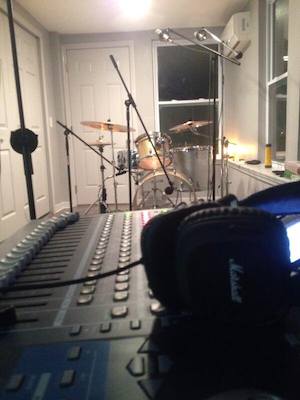 So in the case of recording the drums… Nowadays when you record modern drumming you have a mic above every single thing that the drummer will hit and then you send that to a computer program where really you’re just triggering off another sample of what you really want the drums to sound like, which I find offensive and insulting to drummers. Why do you have them if you don’t like what they sound like?
So in the case of recording the drums… Nowadays when you record modern drumming you have a mic above every single thing that the drummer will hit and then you send that to a computer program where really you’re just triggering off another sample of what you really want the drums to sound like, which I find offensive and insulting to drummers. Why do you have them if you don’t like what they sound like?
That’s ludicrous. So in this case we had one microphone under Jim’s snare. I believe we had one microphone inside of Jim’s kick drum and then we had two condenser mikes sort of in an ‘L’ shape over his toms and cymbals and then mixed them very narrowly in the centre so that there was a lot of definition on the snare and the kick drum but when he would do a roll it would sort of distort, it would sound like it was too loud for the room, and that was completely intentional. During an advance stream we did of I Wanna Be Your Shadow the only negative comment we got was “You might want to turn those drums down during the rolls” and I’m going “That means we have done our job.”
Also, mic’ing the bass was a big component of trying to replicate that sound in some way, or pay tribute to it. Because let’s face it, nobody was recording direct bass at the time. That’s why we mic’ed the guitar and didn’t send it direct. Same deal.
I don’t understand these modern ways of recording. To me, making a record is a record of an event of people playing music together.
I think that the only member of the band that was really given the modern treatment on their instrument was Leslie who was singing through a very new Blue enCORE 200 microphone, which was going into a Samson phantom power pre-amp, which was going into a computer, which was going into a bundle of effects. I think she was the only case where it wasn’t a throwback style of recording.
I don’t understand these modern ways of recording. To me, making a record is a record of an event of people playing music together and I don’t understand why you want to send that off to a bunch of triggers to make it sound like it does when it comes out of a box. It seems very disrespectful of the musicians and that’s why I’m so defiantly into learning about recording and how to best capture what’s going on in my head.
Mixing in this case had everything to do with volume and placement in the speakers. Now of course you have to do some EQing because you’ve got to have some semblance of proper frequency slotting.
And the frequency is that best represents instruments when using frequency slotting are not necessarily the ones you would expect! Like you really want your drums to have a heavy amount of mid-range and the best way to make the bass sit with the kick drum is to actually cut almost everything below 125kHz on the bass.
A great way to get the bass to lock with the kick drum is to cut out a large portion of its bass frequencies because if the rhythm section is tight and they understand what a rhythm section is supposed to do, they will lock together and sound like one instrument when you mix them as such.
Listen to the tight rhythm section on It’s a Beautiful Day
There were a few things added here and there. We did put some limiting on Jim’s snare drum because we just really wanted that snap and we did some reverbs and things on Leslie’s voice, some distortions as we discussed.
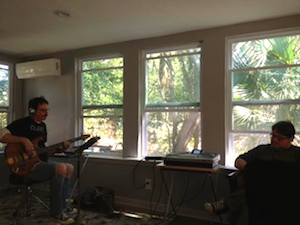 We didn’t use a ton of compression, I went more for limiting just to make sure that the guitar or the bass didn’t take over at various times.
We didn’t use a ton of compression, I went more for limiting just to make sure that the guitar or the bass didn’t take over at various times.
The only instrument we really applied compression to was the bass, to keep it in check with the rhythm section. As you can hear, Guy is all over that fretboard and if you’ve mic’ed a bass amp then the higher you go on the bass, the louder that note is. So we had to keep that volume in check and that led to a lot of limiting and compression but it added up for the best.
It ended up with the vintage bass tone that we were going for. You know when you see footage of Santana playing at Woodstock and the bass player is playing that abnormally-large acoustic amp but somehow he’s getting this almost distorted and farty sound of it? That is my favourite bass tone. And we got that out of a 5 Watt Vox practice amp.
Once I had a finished two track mix that I really liked, there’s this cardinal rule that you don’t master what you mix… and I have never observed that in my life! But in this case, I was trying to represent not just the tastes and skills of four individual musicians but also the taste of the fictitious Claire and the fictitious Potatoes and I believe that fictitious band would hire an outside masterer.
If I’d mastered the record it would have very much sounded like “Popular Music Part 2” so we took it to a local man named Justin Beckler. He produced the last Milk Carton Superstars album called Sesame Street Car Named Disaster and I’m a huge fan of the sound of that record. I know he knows his s***. Unless I can’t swear in this interview, in which case: I know he knows his stuff.
I’m a workaholic. I don’t know how to stop creating and I don’t understand people that are unfocused about it. So I’ve chosen to work with very focused and driven individuals, and that has been very rewarding for me.
He mastered the album really mostly in one night and I just sat there with him yes-or-no-ing things and that was another case where I had to step back and let him assume control. We brought him in because we love what he does so the intention was: let him work. Let him do what he’s good at.
The only cases where there were ever suggestions on my part were “Okay, well maybe those dynamics are a little squashed” or “I’m still hearing a lot of hiss on the quiet part of The Real Enemy” and he waved his hand Jedi-style and fixed all of those things immediately.
That was another case where I showed up at his house 7:30pm and I left at midnight with a master. He knew what we were going for, he’s a very gifted listener and there wasn’t really a lot of small talk or anything. We just got to work.
That tends to be why I ramble so much in interviews: because I’m a workaholic. I don’t know how to stop creating and I don’t understand people that are unfocused about it. So I’ve chosen to work with very focused and driven individuals, and that has been very rewarding for me. And Justin is just so damn efficient!
That was basically the tale of mixing and mastering the album. It was recording at our homes, mixed at mine and mastered by Justin Beckler.
I wouldn’t recommend my version of recording to anyone else and it doesn’t really make a lot of sense to others until they hear the finished product.
I was very lucky that Claire and The Potatoes as a band trusted me to take the reigns and make this album sound a certain way, because nowadays when you think “I want to record” well, some folks still immediately think “Let’s get an outside producer”. And I think I made it clear to the band that I had a vision for how we could best represent our sound and they trusted me implicitly with it and that was very fortunate for me.
I think that since that vision included taking all of their wants and needs and how to highlight their skills, since it included me really looking out for them, it ended up producing an album that we are much happier with than if we had hired Joe Blow down the street to do a Pro Tools job.
There wasn’t a lot of punching in. There wasn’t stitching together drum tracks. Each thing was one take. We didn’t splice anything together. I don’t think we would know how to work that way, really. Most people who dabble in recording would look at my methods and then equipment that I’m using and the microphones that I’m using and go “How the hell do you expect to make a record with that!?”
People are always surprised to find out what I use. I tend to keep it a little quiet.
In the final part of this interview Marc tells us about his music education and how his musical ear developed.
The new album Have An Okay Time With Claire And The Potatoes will be released on July 15th 2014 but you can pre-order it now.
UPDATE: The album is now available!

